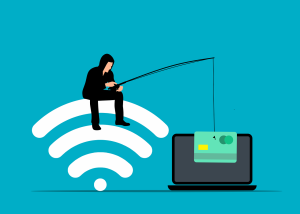As a business owner, you face many kinds of threats to your success.
Cybercriminals, hackers, and other malicious actors are all looking for ways to take advantage of you and your business. One of the more popular methods is called “phishing.”
Let’s explore five major kinds of phishing scams currently out there – and how you can protect yourself from being hooked.
What is Phishing?
Phishing scams are emails that attempt to trick people into giving away their personal information: Login credentials, credit cards, banking info, or social security numbers.
Though there are different kinds of Phishing attacks, they’re all attempting to do pretty much the same stuff:
-
- Persuade you to share personal and/or financial information
- Encourage you to click on malicious links
- Tempt you to download harmful software and applications
1: Email Phishing
This is the most common form of phishing scam. The messages often appear to be from a legitimate source – like a bank, social media platform, or online retailer – but they’re actually fake accounts created by scammers.
These scams can be incredibly convincing, often using logos or language that looks and feels like a legitimate source. But, keep in mind, legitimate businesses, government agencies, and financial institutions won’t ask for personal information, or pressure you to act immediately. Instead, they’ll provide you with all the necessary information and give you the time you need to make an informed decision.
So, be wary of opening suspicious e-mails and never provide your personal information unless you’re absolutely sure it’s safe to do so. Always check the email address from where the message is sent from. For example: A real message from Google comes from Google.com, not Google.net!
Remember, it’s better to be safe than sorry!
2: Smishing
Again, the goals are generally the same no matter the method – convince people to give up sensitive information. Smishing attempts to pull off this scam in text form.
The term smishing, derived from the words “SMS” and “phishing,” is the texting variation on the classic email phishing.
With the prevalence of mobile devices and text messaging, it’s a common scam. As with email attacks, be very careful when clicking on links that have been texted to you from an untrusted source. And, again, don’t offer your personal information unless you’re sure it’s safe to do so.
3: Vishing
Voice phishing, or “vishing,” is another sneaky way fraudsters try to gain your personal information. Taking an old school approach, this technique involves having an actual conversation with a scammer.
Some cybercriminals feel that it’s easier to bully people into handing over money and information by talking directly to them, rather than through email or text.
They’ll often speak in a demanding tone, trying to overwhelm the victim with urgency and panic. They may also claim to be from the IRS or something – but government agencies rarely call out of the blue without being contacted first, so treat such a call with some healthy skepticism.
One simple way to prevent vishing: If you get a call from a number you don’t recognize, then let it go to voicemail. Once you’ve listened to the message, you can decide if you want to call them back.
And if you do get caught up in a call you think may be a scam, then hang up right away, and block the number.
4: Spear Phishing
Spear phishing is a targeted attack that zeroes in on a specific individual within a company or organization.
Unlike traditional phishing scams, which cast a wide net and hope for the best, spear phishing involves careful research to identify vulnerable targets.
The result is a highly personalized approach that can be devastatingly effective. Spear phishing emails may appear to come from trusted sources within the company, making it hard for individuals to identify the scam.
The consequences of falling victim to a spear phishing attack can be severe, ranging from compromised personal information to devastating financial loss.
5: Whaling
Taking spear phishing to the next level, whaling is a targeted attack on a company’s CEO, or other high-ranking chief officer.
This “CEO fraud” seeks to extract sensitive information and money transfers from the highest levels of a company.
One of the key tactics of a whaling attack is to spoof (or mimic) the email address of a lower-level executive, in order to make the message appear legitimate to the CEO. This tactic makes whaling phishing all the more dangerous, since attackers can take advantage of the trust leaders have in their management team.
How to Protect Yourself
Phishing attacks have become one of the biggest problems of the online world. These attacks are designed to manipulate people into making mistakes that can cause some serious damage to their identities and their bank accounts.
One of the best ways to safeguard your accounts is by using multi-factor authentication. It adds an extra layer of security to your accounts and makes it extremely difficult for hackers to access them.
Additionally, keeping all your computers and mobile devices up-to-date with the latest software updates is also important. These updates enhance the security features of your devices and reduce the risk of any vulnerability being exploited.
Also, be careful of any messages that come out of the blue, especially when they’re marked urgent, or offer something that seems too good to be true.
And get really suspicious if they ask for any information or present unexpected links. It could be a trap.
How to Report Phishing
Phishing attempts are becoming more and more common these days, with scammers trying to figure out new ways to lure unsuspecting victims into divulging their personal information.
The good news is that we can fight back. Report them. Any information you give helps to identify patterns and trends that can be used to stop these criminals in their tracks.
-
- If you get a phishing email, forward it to the Anti-Phishing Working Group at reportphishing@apwg.org
- If you get a phishing text message, forward it to SPAM (7726)
- Report any phishing attempts to the FTC at Report.Fraud.ftc.gov
An Effective Defense
Cybersecurity has become an increasingly important aspect in today’s digital age. With more and more sensitive information being shared online, it’s important to protect ourselves from cyber threats.
If you’re looking for an extra layer of security for your emails and website, contact Smart Link Solutions.
Contact us today to learn more about how we can help you safeguard your online presence.

